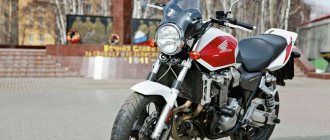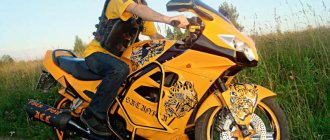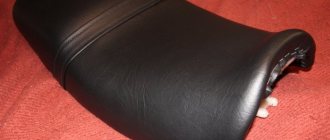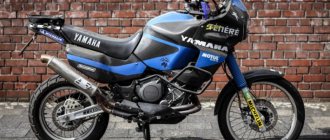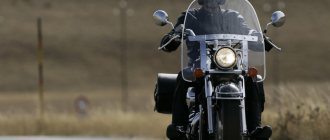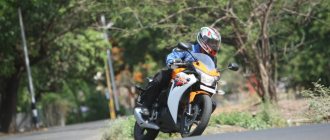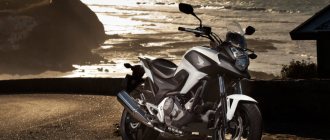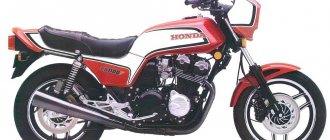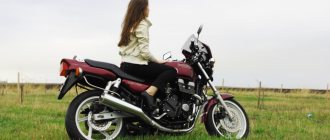Bike features
Here are the main features of the machine:
- excellent vintage design and lack of plastic in the exterior;
- hard seat;
- Small dimensions, the motorcycle is not suitable for two.
The disadvantages of this bike in no way prevent the model from remaining one of the best retro classics at the budget level. Yes, there is a small design flaw in that the engine is made of gray aluminum, and it would have been much more correct for the manufacturer to make it chrome. But this is a minor minus.
Maintainability
How much will it cost to repair a Honda CB400?
The motorcycle has proven itself to be a reliable unit without any problems with operation and repair. The only generally recognized defect is the malfunction of the relay regulator. This device often fails and cannot be repaired. Replacing a part will cost approximately 1000 rubles and 5 minutes of time. The power unit is quite reliable under normal operating conditions, but in case of wear, it is better to replace the unit completely. You can order it in specialized stores. A contract engine, depending on the year of manufacture, will cost from 26 to 39 thousand rubles.
Maintenance
In terms of maintenance, all Honda cb400 models are not particularly picky. As consumables, only the air filter can be replaced, which is replaced during maintenance or as needed. When used in harsh conditions, the air filter becomes clogged, resulting in reduced power and increased fuel consumption. In some cases, the motorcycle begins to jerk when changing gears. Fixing this problem will cost about 700 rubles; you can do the work of replacing the filter yourself.
Dimensions and weight
This motorcycle is definitely not big. It barely fits even the average size. The CB 400 SS is 2145 mm long, 780 mm wide and 1125 mm high. The wheelbase here is 1405 mm, and the seat height is 790 mm. The curb weight of the model is 159 kg, and the tank volume is only 11 liters. Gasoline consumption per 100 km is insignificant - about 3 liters.
Honda CB 400 SS review.
There are very few motorcycles in our world that will not leave anyone indifferent. And one of them is a retro classic from the company HONDA CB 400 SS (not to be confused with the CB400SF - this is a completely different motorcycle).
For girls who love bright plastic and edited photos for Instagram, SSka evokes only one reaction - wow, what an ugliness! Approximately the same opinion is expressed by young men who dream of driving 200+ km/h in the rear between rows. For most, this motorcycle evokes either tenderness or nostalgia. "ABOUT! Looks like my Sunrise!” “Here is a motorcycle that looks like a motorcycle!” And so on. Most people who see this motorcycle for the first time smile when they look at it.
It may seem that the motorcycle was created around 1965 of the last century. In fact, this model is a contemporary of the most popular SuperFura (Honda CB400SF), CBR600F4, BMW R1150RT/GS. In fact, SSki's contemporaries had an injector, ABS, disc brakes on both wheels, and a water engine cooling system. But all this was not on the archaic SSke and did not appear for almost ten years of its production. Even the electric starter appeared only five years after the appearance of the first motorcycles.
Honda began production of the CCski in 2002, but three years before that the CL400 model was released - it is absolutely the same motorcycle, differing only in small things, namely, the absence of a tachometer, a different exhaust system: there were two exhaust pipes and they were raised much higher, the fuel tank was one liter larger. If the CL400 was positioned as a motorcycle more for country roads, then the SS was positioned as a pure city dweller. The motorcycle lasted on the factory assembly line until 2008 inclusive.
The SSka has the following technical characteristics: a single-cylinder engine with a volume of 397 cm3, producing 29 hp, a carburetor, a kick starter (since 2004, an electric starter has also appeared), a rear drum brake, a semi-duplex steel frame, a telescopic fork at the front and a double shock absorber at the rear, a 5-speed gearbox, spoked wheels, a metal fuel tank with a capacity of 11 liters, on which the motorcycle can travel about 200 km. The motorcycle turned out to be simple, reliable and trouble-free. If you take care of it, it can last forever.
The motorcycle is short, light, small, perfect for any height, up to 190 cm, quite playful (for its class), easy to control due to its low weight, dimensions and low center of gravity.
As a training vehicle, it is perfect for first trips into the city, practicing basic elements at medium speeds, short commuter trips and practicing movement in dense city traffic.
Motorcycles of this model can often be found on modern city streets, at motorcycle festivals, in the opening and closing columns of motorcycle seasons, etc. The motorcycle remains popular and relevant to this day among lovers of retro classics, and it has very few competitors in this segment.
Author: Dmitry Agapov, instructor of the Acategory motorcycle school.
Chassis and brakes
The semi-duplex frame of this motorcycle is made of steel. Its appearance exactly conveys the exterior of those motorcycles that traveled around the world in the 60s of the last century. Of course, the wheels here are spoked, and the steering wheel has dimensions corresponding to the class.
At the rear, a pendulum version with a double shock absorber is used as a suspension. At the front it is a telescopic fork. The rear brake is a drum, and the front brake is a disc and a two-piston caliper. It is worth considering that the brakes here are not strong enough in relation to the engine power, and therefore you will either have to somehow solve this problem yourself, or never reach critical speeds.
Tuning
The motorcycle has a classic style, but many find it quite boring and tune the motorcycle. The Honda CB400 should be equipped with roll bars and a windshield as necessary upgrades.
- Installing the arches protects the crankcase cover, tank and other structural elements in the event of a fall. You can purchase Honda cb400 roll bars in most specialized online stores, the cost will be 4 – 6 thousand rubles.
- At speeds over 120 km/h, the oncoming air flow blows away strongly; purchasing a windshield for 2-3 thousand built into the headlight will significantly increase driving comfort.
- To give the motorcycle some sportiness, you can install plastic exhaust fairings. This does not provide any useful load, but it does give the motorcycle some personality.
- For lovers of long trips, you can install a luggage case on special mounts. It will cost 6-8 thousand, but it's worth it.
Tuning for sports
Advantages and disadvantages
pros
- Reliability. The motorcycle very rarely breaks down. Repairable, no problems with spare parts.
- Dynamism. Good speed and dynamic performance.
- Maneuverability. It easily avoids uneven roads and maneuvers well in city traffic jams.
- Popularity of the model. There are no problems with repairs and finding spare parts and consumables.
Minuses
Read other motorcycle reviews Review of the Minsk D4 125 motorcycle
- Outdated appearance. The motorcycle looks like a relic of the 20th century.
- Softness of the front fork. There are unpleasant pecks on uneven surfaces. The problem is solved by installing stiffer springs or replacing the oil with a more viscous one.
- Problems with the relay regulator on models before 1999. You have to carry a spare regulator with you when traveling long distances.
Owner reviews
Screenshot No. 1. Owner's review of the Honda CB400
Ilya, 32 years old
The motorcycle is very reliable, ideal as a first bike. The speed picks up quickly, fuel consumption is minimal, especially when you are driving alone. The handling and maneuverability are simply amazing; neither city traffic jams nor potholes are scary. I drove it for two seasons, no problems, never broke down due to my own fault. Due to the driver's misfortune, it was once repaired; it landed very hard; as a result, the headlight and instrument panel had to be replaced. The Honda cb400 dashboard and Honda cb400 headlight cost me 7900 and 2500 respectively. I installed it myself, nothing complicated. I’ll skate another season and will sell it, the equipment is good, but I’ll take something more serious.
Screenshot No. 2. Review from a Honda CB400 owner
Specifications
In 1999, the model received its own development, Hyper Vtec. It automatically connects different engine operating modes, thereby increasing its service life.
In 2008, while remaining a third-party system, it formed the basis of a new fuel supply system . Due to restrictions in Japanese legislation, a weak motor could not always produce the desired parameters. The system gave him a “second wind”, allowing him to get more power without violating the restrictions.
Engine – right side view.
Engine – left view.
Since 2008, the bike began to receive a 4-stroke, 4-cylinder engine.
- working volume - 399 cm3;
- power - 53 hp;
- number of valves - 4;
- cooling - liquid;
- fuel supply - injector (since 2008);
The new models have a PGM-FI injection system.
- ignition - electronic;
- start - electric starter;
- fuel tank - 18 l.
The in-line arrangement of the cylinders, as well as the ability to increase service life in automatic mode, made it possible to create a practically indestructible engine.
Transmission and
The main drive is a classic chain drive.
The bike is equipped with a 6-speed gearbox. Own development.
The retuned number allowed the following effect to be crushed from the sequential box:
- The first 5 gears use only 2 of the 4 valves on each cylinder . For full power you need at least 6500 rpm, which is quite high for urban driving conditions.
- If you switch to 6th gear, the entire valve block acts immediately . This gradual increase in power makes it possible to touch the pedal less often and control the gas better.
clutch
The bike has a multi-disc clutch and operates in an oil bath. The main drive is a chain.
Brakes
From the very beginning of production, the front axle had disc versions. The rear discs were received in 1999.
Front brakes.
Rear brakes.
The brake parameters have been revised several times. According to data from 2010 (latest decisions), the bike’s brakes have the following parameters:
Front:
- number of disks - 2;
- disc diameter - 285 mm;
- support - 2 piston, floating.
Rear:
- number of disks - 1;
- disc diameter - 235 mm;
- support - 1 piston, floating.
ABS is available as an option: front only, rear only, or 2 wheels at once.
